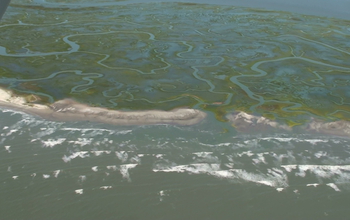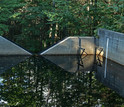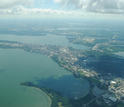Annual NSF Long-Term Ecological Research mini-symposium to take place March 21
 Marshes absorb wave energy, helping protect coasts from severe storms and sea level rise. Credit and Larger Versión |
February 24, 2017
On March 21, scientists from across the National Science Foundation's (NSF) Long-Term Ecological Research (LTER) Network will take part in an annual mini-symposium, presenting results on how ecosystems from coast to coast are changing. The symposium takes place the day before World Water Day, a yearly celebration of our planet's water resources.
How healthy will Earth's ecosystems, which ultimately depend on water, be by World Water Day 2027, 2067 and beyond? Topics at the mini-symposium range from dryland desertification and resilient coasts to the warming Arctic and U.S. Northeast forests recovering from acid rain.
LTER scientists will discuss long-term research that can help us understand what leads to ecosystem recovery, and what irreversibly transforms ecosystems.
These researchers have found that while many ecosystems show signs of pressure, there's hope amid the concerns. Some ecosystems are benefiting from protection and restoration efforts.
In addition to the scientists' mini-symposium talks, posters explaining findings from LTER projects will be on display throughout the meeting.
For more on NSF's LTER program, please see: NSF LTER Network and NSF Long-Term Ecological Research Discovery Articles.
| WHO | NSF LTER Network Scientists |
| WHAT | NSF LTER Annual Mini-Symposium |
| WHEN | Tuesday, March 21, 2017, 8:30 a.m. – 1:00 p.m. ET |
| WHERE | National Science Foundation, Room 375 4201 Wilson Boulevard, Arlington, VA 22230 |
| CONTACT | For more information, or for a pass to gain entry into the NSF building, please contact Cheryl Dybas at cdybas@nsf.gov, or (703) 292-7734. |
| 8:30 a.m. | Coffee, posters, display of Schoolyard LTER book series |
| 9:00 a.m. | Introduction: Paula Mabee, Director, NSF Division of Environmental Biology |
| 9:05 a.m. | LTER introduction: The nature of ecological change Peter Groffman, chair, LTER Executive Board, Cary Institute of Ecosystem Studies and City University of New York, co-principal investigator, Baltimore Ecosystem Study LTER |
| 9:15 a.m. | Beyond desertification: New models for state change in drylands Brandon Bestelmeyer, USDA-ARS, Jornada Experimental Range, co-principal investigator, Jornada Basin LTER |
| 9:35 a.m. | Fire and ice: Carbon cycling feedbacks to climate in a warming Arctic Michelle Mack, Northern Arizona University, co-principal investigator, Bonanza Creek LTER |
| 9:55 a.m. | Climate-resilient coasts: How long-term research and restoration informs management Karen McGlathery, University of Virginia, principal investigator, Virginia Coast Reserve LTER |
| 10:15 a.m. | Break |
| 10:30 a.m. | Remarks James Olds, NSF assistant director for Biological Sciences or Jane Silverthorne, NSF deputy assistant director for Biological Sciences |
| 10:45 a.m. | De-acidification of northeastern forests: An altered baseline? Charles Driscoll, Syracuse University, co-principal investigator, Hubbard Brook LTER |
| 11:05 a.m. | Plausible freshwater futures: Yahara watershed, Wisconsin, USA Christopher Kucharik, University of Wisconsin-Madison, co-principal investigator, North Temperate Lakes LTER |
| 11:25 a.m.- 12:15 p.m. | Panel discussion: How can long-term science contribute to effective ecosystem management? Moderator: Frank Davis, director, LTER Network Communications Office |
| 12:15- 12:20 p.m. | Closing Richard Murray, director, NSF Division of Ocean Sciences |
| 12:20- 1:00 p.m. | Reception |
NSF LTER Mini-Symposium Presentation Abstracts
The nature of ecological change
Peter Groffman, chair, LTER Executive Board, Cary Institute of Ecosystem Studies and City University of New York; co-principal investigator, Baltimore Ecosystem Study LTER
Change, stability, thresholds and resilience have been among the greatest challenges in ecology. These challenges can only be met with the type of coordinated, long-term science supported by the LTER program.
Beyond desertification: New models for state change in drylands
Brandon Bestelmeyer, USDA-Agricultural Research Service, Jornada Basin LTER
One of the classic ecosystem change stories is that over-grazing and drought turn grasslands into shrubby, degraded landscapes. Researchers at the Jornada Basin LTER site and its host, the USDA Jornada Experimental Range, have developed a new model of desert grassland ecosystem that's based on long-term data and experiments. Even after abrupt changes in plant life, gradual recovery appears to be possible -- sometimes along unexpected pathways -- as long as critical thresholds in species abundance and soil erosion are not crossed.
Fire and ice: Carbon cycling feedbacks in a warming Arctic
Michelle Mack, Northern Arizona University, Bonanza Creek LTER
About 30 percent of global carbon is in the vegetation and deep, carbon-rich soils of Arctic tundra and boreal forest ecosystems. Wildfires -- which are becoming more frequent with warmer and drier weather in the Arctic -- have the potential to stabilize or accelerate regional and global environmental change through carbon feedbacks. By comparing the effects of fire in the boreal forests of Alaska, where fire has been common for the past 10,000 years, with Alaska's North Slope, where fire is a new disturbance, researchers are beginning to understand the ways fire interacts with plant life, nutrients in soils, and permafrost to influence ecosystem stability.
Resilient coasts: How long-term research and restoration informs management
Karen McGlathery, University of Virginia, Virginia Coast Reserve LTER
Coastal habitats are the first line of defense against sea-level rise and severe storms. They're also vulnerable to change. A long-term, landscape-scale experiment with seagrasses at the Virginia Coast Reserve LTER is the first of its kind to show the role of restoration in reinstating ecosystem services, especially in what's known as "blue carbon" sequestration. Fifteen years of data on recovery and resilience to high ocean temperatures provide new insights that are being integrated into predictive models of future change, and informing management and policy decisions.
De-acidification of northeastern forests: An altered baseline?
Charles Driscoll, Syracuse University, Hubbard Brook LTER
Air pollution control efforts have succeeded in reducing sulfur dioxide and nitrogen oxide emissions, but decades of acid rain have leached calcium and magnesium out of northeastern forest soils. These changes have altered the long-term future for forest ecosystems by changing what's in woodland soils. What does the acid rain story say about when, where and how recovery is posible?
Plausible freshwater futures: Yahara watershed, Wisconsin, USA
Christopher Kucharik, University of Wisconsin-Madison, North Temperate Lakes LTER
Scenarios can help communities think about alternative futures, but using them to drive decisions requires data. In Wisconsin's Yahara Watershed, researchers are combining data and modelling from the North Temperate Lakes LTER site with scenarios based on trends and events from the global scientific literature and stakeholder perspectives. The resulting assessments can help guide decisions about land and water use in ways that meet needs for human well-being, preserve ecosystems' ability to provide "services" such as fresh water and fertile fields, and build resilience for unpredictable environmental changes.
-NSF-
Media Contacts Cheryl Dybas, NSF, (703) 292-7734, cdybas@nsf.gov
The National Science Foundation (NSF) is an independent federal agency that supports fundamental research and education across all fields of science and engineering. In fiscal year (FY) 2016, its budget is $7.5 billion. NSF funds reach all 50 states through grants to nearly 2,000 colleges, universities and other institutions. Each year, NSF receives more than 48,000 competitive proposals for funding and makes about 12,000 new funding awards. NSF also awards about $626 million in professional and service contracts yearly.
Useful NSF Web Sites:NSF Home Page: https://www.nsf.gov
NSF News: https://www.nsf.gov/news/
For the News Media: https://www.nsf.gov/news/newsroom.jsp
Science and Engineering Statistics: https://www.nsf.gov/statistics/
Awards Searches: https://www.nsf.gov/awardsearch/
Shrubs and grasses in the already dry Chihuahuan Desert are further affected by drought.
Credit and Larger Version

LTER scientists work to determine what affects forest recovery after a fire.
Credit and Larger Version

Weirs at the NSF Hubbard Brook LTER site provided keys to identifying acid rain in the 1960s.
Credit and Larger Version

Scientists take samples of a restored seagrass meadow at the NSF Virginia Coast Reserve LTER site.
Credit and Larger Version

LTER researchers study water quality and supply in the four lakes of the Yahara River watershed.
Credit and Larger Version
The National Science Foundation (NSF) a vuelo
Guillermo Gonzalo Sánchez Achutegui
ayabaca@gmail.com
ayabaca@hotmail.com
ayabaca@yahoo.com
Inscríbete en el Foro del blog y participa : A Vuelo De Un Quinde - El Foro!
No hay comentarios:
Publicar un comentario
Por favor deja tus opiniones, comentarios y/o sugerencias para que nosotros podamos mejorar cada día. Gracias !!!.